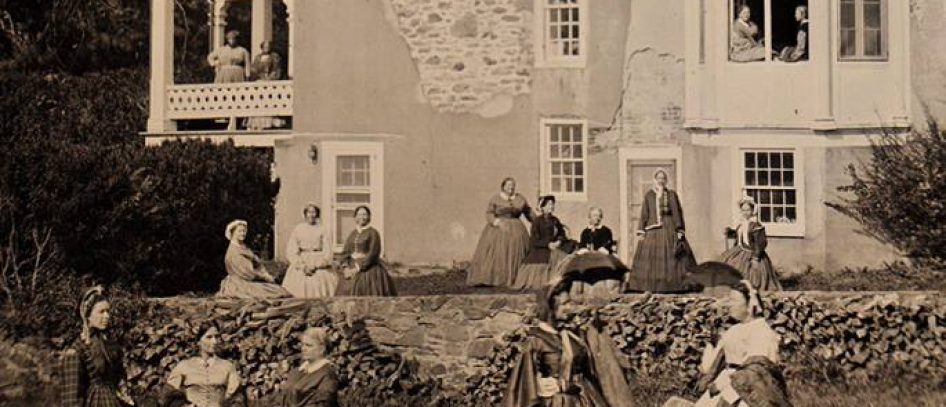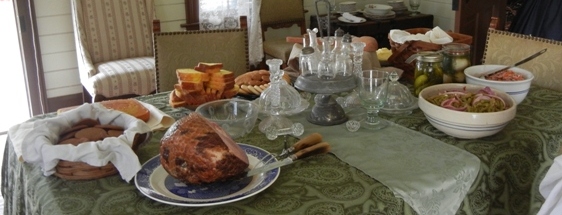Foods to consider taking to events:
- Slab bacon, pickled pork and/or corned beef, (not the stuff one typically gets at the local grocer, but properly cured.)
- Corn meal or flour
- Round wheel of cheese, preserved by rubbing with butter
- Lard
- Fresh eggs from the farm (unwashed), keeps about a week when kept out of direct sunlight
- Dried Beans
- Dark brown sugar or white loaf sugar (broken into chunks)
- Molasses
- Period appropriate fruits and vegetables (generally something like apples, Irish potatoes, sweet potatoes, onions, carrots, or other seasonal type food from the garden or orchard, or from the cellar.
- Coffee and/or coffee substitutes
- Homemade bread
- Jumble cookies
- Gingerbread
- Pickled eggs
- Fried dried apples or fried apple pies
- Dried peach pudding
- Pickles
- Canned goods with period labels and used with period openers
- Condiments such as pepper sauce, mustard and mushroom catsup
- Modern-day “off-the-shelf” foods chosen carefully for their resemblance to period foods are acceptable
Other Resources
Search period cookbooks for ideas as well. A listing of period cookbooks can be found in the Bibliography under Resources on this website.
For additional information on period cooking visit Foods and Cooking under Daily Life on this website. Another resource is “Re-staging an 1861 Picnic Or a Civilian Living History Activity for First Manassas”, page 30-35, Civil War Historian Magazine, May/June 2006, Volume 2 Issue 2.
From Bacon, Beans, and Galantines by Joseph R Conlin. This book deals mostly with the California Gold Rush; however, food descriptions should be applicable to the 1860s as well.
Page 8: “…Samuel Griswold Goodrich described a New England breakfast as ‘no evanescent thing. In a farmer’s family it consists of little less than ham, beef, sausages, pork, bread, butter, boiled potatoes, pies, coffee, and cider.’…John Mack Faragher describes the daily diet of a midwestern [sic] farm family of mid-century as including two kinds of meat, eggs, cheese, butter, cream (especially in gravies), corn in one or more forms, tow kinds of bread, three or four different vegetables, jellies, preserves, relishes, cake or pie, milk, coffee, tea.”
Page 11: “By mid-century beef was replacing pork in the Northeast but pigmeat remained the cushion of southern comfort. There were nearly two hogs per capita in most of the southern states…A writer in Godey’s Lady’s Book sums it up: ‘[In the] South and West…it is fat bacon and pork, fat bacon and pork only, and that continually morning, noon, and night, for all classes, sexes, ages, and conditions; and except the boiled bacon and collards at dinner, the meat is generally fired, and thus supersaturated with grease in the form of hog’s lard.’”
Page 12: “…[Corn] was the staple of the South, eaten in mush, cooked before an open fire as ‘pone’ or hoecake, and baked into a more or less proper bread.”
Page 14: “Beans were ubiquitous at home…”
Page 16: “…common fare during the 1840s were broccoli and artichokes. Other vegetables, of which there are numerous off-handed recipes in the cookbooks and references in the marker reports, were asparagus, lima beans, haricot or string beans, cucumber, eggplant, mushrooms, okra, rutabagas, salsify, and spinach, as well as tomatoes.
“..eating greens and other vegetables raw seems not to have been uncommon….the common American salad was…’composed’ of a variety of vegetables and dressed with a sweetish mayonnaise-based liquor much like the substance contemporary bottlers sometimes label ‘French Dressing.’
“Then there were the preserved vegetables and fruits…”

